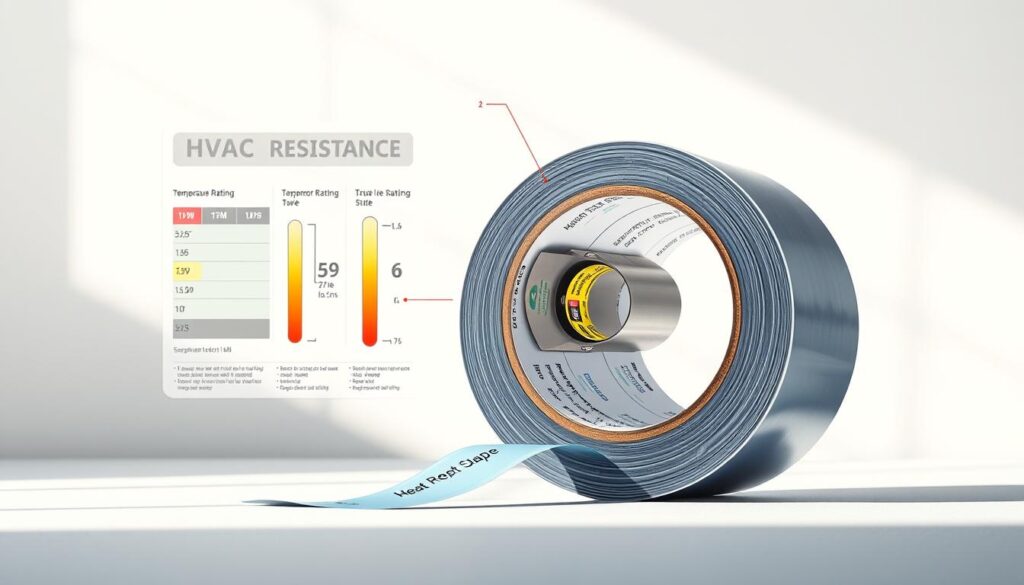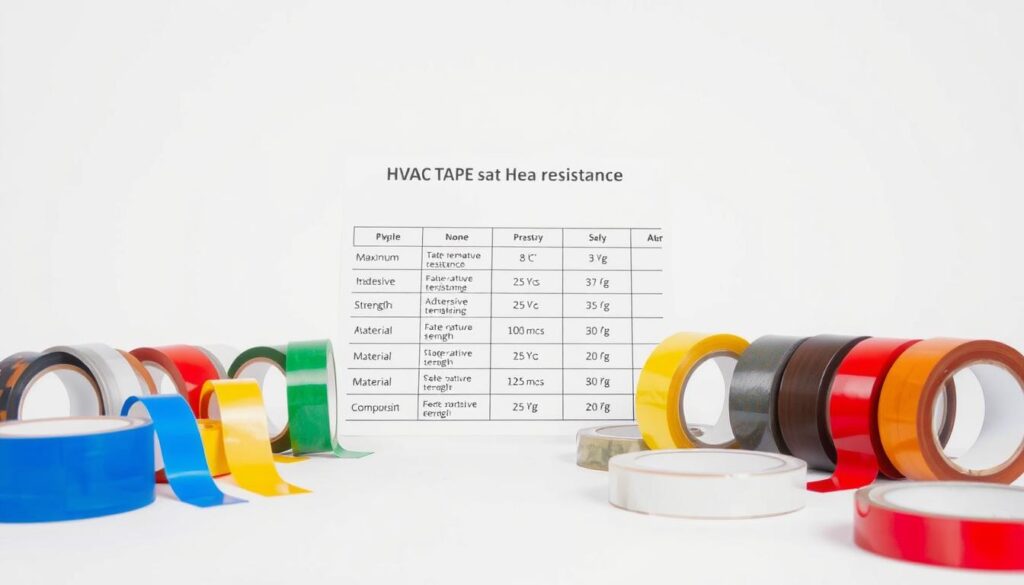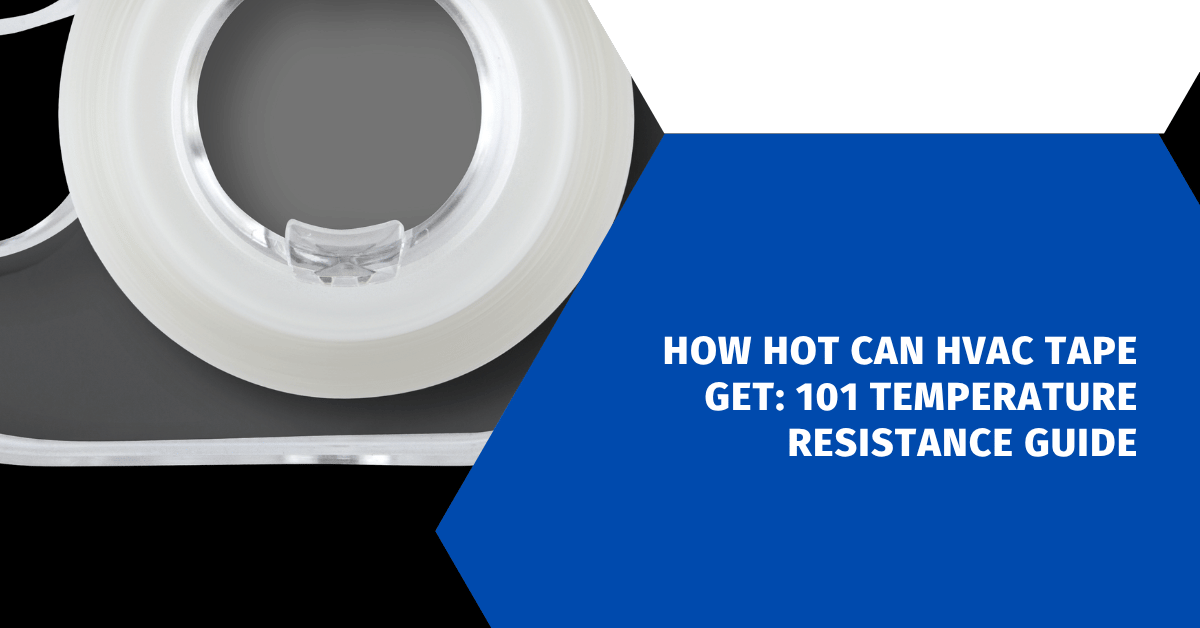Affiliate Disclosure
HVAC Guide Guys is a participant in the Amazon Services LLC Associates Program, an affiliate advertising program designed to provide a means for sites to earn advertising fees by advertising and linking to Amazon.
How Hot Can HVAC Tape Get? Ever thought about how much heat your HVAC tape can take before it fails? The world of heat-resistant HVAC tape is more complex than many think.

HVAC tape’s heat resistance varies a lot. Different materials can handle cold or heat differently. Most tapes can handle up to 250-300°F. But, some jobs need even more.
Knowing how hot HVAC tape can get is key for a system that lasts. How well it does depends on the tape’s material, adhesive, and where it’s used.
Key Takeaways
- HVAC tapes have diverse temperature performance capabilities
- Temperature resistance ranges from -65°F to 600°F
- Specialized tapes exist for extreme temperature environments
- Material composition significantly impacts heat tolerance
- Proper tape selection prevents possible system failures
Table of Contents
Understanding Temperature Ratings of HVAC Tape
Exploring HVAC tape temperature ratings can be tricky. It’s important to know the safe operating temperature of HVAC tape. This ensures your heating and cooling systems work well and last long.
Temperature Rating Systems Explained
HVAC tape temperature ratings come from thorough testing. This testing checks how the tape performs under different conditions. The highest temperature an HVAC tape can handle depends on:
- Adhesive composition
- Backing material
- Intended application
- Environmental conditions
Short-term vs Long-term Heat Exposure
It’s key to know the difference between short-term and long-term heat exposure. For example, UL 181A-P/B-FX Listed AF 099 foil tape stands out for its heat resistance:
| Exposure Type | Temperature Range |
|---|---|
| Service Temperature Range | -20°F to 260°F |
| Short-term Exposure | Up to 300°F |
| Long-term Exposure | Typically 180°F to 200°F |
Industry Standards for Heat Resistance
For professional HVAC work, strict standards are followed. UL Listings are key for checking heat resistance. They cover:
- Flame resistance
- Humidity tolerance
- Static load performance
- Adhesion strength
“Choosing the right temperature rating is vital for HVAC system efficiency and avoiding tape failure.”
When picking HVAC tape, think about your project’s temperature needs. This ensures the tape works well and is safe.
How Hot Can HVAC Tape Get: Maximum Temperature Limits
Knowing the heat limits of HVAC insulation tape is key for top performance and safety. The thermal rating of HVAC tape changes a lot based on the material and use.
Various HVAC tapes can handle high temperatures. Let’s look at the highest temperatures different tapes can handle:
- Aluminum foil tapes can go up to 600°F (316°C)
- Polyimide (Kapton) tapes can handle around 500°F (260°C)
- Silicone adhesive tapes can resist heat up to 500°F (260°C) for short times
- Glass cloth tapes can handle temperatures from -65°F to 450°F (-54°C to 232°C)
When picking HVAC tape, think about the temperature needs of your project. The right tape can greatly improve system performance and life.
| Tape Type | Max Temperature | Best Applications |
|---|---|---|
| Aluminum Foil Tape | 600°F (316°C) | HVAC ductwork, high-heat environments |
| Polyimide Tape | 500°F (260°C) | Electronics, aerospace applications |
| Silicone Adhesive Tape | 500°F (260°C) | Short-term high-heat scenarios |
“Selecting the right HVAC tape is about matching thermal performance to your specific environmental demands.” – HVAC Engineering Experts
The heat limits of HVAC insulation tape can differ by brand and product. Always check the manufacturer’s specs and test properly to ensure reliability in your application.
Explore Our HVAC Shop
Looking for top-rated HVAC tools, parts, and accessories? Visit our shop and find the perfect solution for your needs.
Visit the ShopTypes of Heat-Resistant HVAC Tapes
Choosing the right high-heat HVAC tape is key to keeping systems running well and avoiding breakdowns. Different tapes handle high temperatures in unique ways, making them perfect for various needs.
The HVAC world has many specialized tapes for extreme heat and tough environments. Knowing about these can help you pick the best for your project.
Aluminum Foil Tape
Aluminum foil tape is a top choice for HVAC jobs. It shines because of:
- Great heat reflection
- Stays dry
- Works from 200°F to 600°F (93°C to 315°C)
- Perfect for sealing and insulating ducts
Silicone Adhesive Tape
Silicone adhesive tapes are flexible with temperature and perform well:
- Handles -60°F to 500°F (-51°C to 260°C)
- Stays sticky in harsh conditions
- Great for cars and planes
Glass Cloth Tape
Glass cloth tape is tough for very hot places:
- Can take over 500°F (260°C)
- Good electrical insulation
- Used a lot in factories
“Choosing the right high-heat HVAC tape is not just about temperature resistance, but also about understanding the specific performance requirements of your application.”
| Tape Type | Temperature Range | Primary Applications |
|---|---|---|
| Aluminum Foil Tape | 200°F – 600°F | Duct Sealing, Insulation |
| Silicone Adhesive Tape | -60°F – 500°F | Automotive, Aerospace |
| Glass Cloth Tape | Up to 500°F | Industrial Insulation |
When picking your high-heat HVAC tape, think about temperature, environment, and your specific needs. This ensures the tape works well and lasts long.
Explore Our HVAC Shop
Looking for top-rated HVAC tools, parts, and accessories? Visit our shop and find the perfect solution for your needs.
Visit the ShopTemperature Range for Common HVAC Applications
Knowing the temperature range for heat tolerant HVAC tape is key. It helps keep heating and cooling systems running well. Foil tapes are important for sealing ducts and boosting HVAC performance.
When picking HVAC tape, its heat resistance matters a lot. Each use needs a tape that can handle certain temperatures:
- Residential HVAC systems: -20°F to 260°F
- Commercial ductwork: -30°F to 300°F
- Industrial applications: Up to 600°F
Experts say certain tapes are best for different temperatures:
- Shurtape AF 099 Aluminum Foil Tape: Great for usual temperatures
- Shurtape AF 914CT Cold Temperature Tape: Works well in very cold
- Shurtape SF 686 ShurMASTIC® Butyl Foil Tape: Best for controlling moisture
“Choosing the right tape ensures optimal HVAC system performance and energy efficiency.”
When picking your HVAC tape, think about temperature changes, surface types, and your environment. This ensures your seal lasts and works well.
Factors Affecting HVAC Tape Heat Resistance
To know how hot HVAC tape can get, we need to look at several key factors. The maximum temperature for HVAC tape isn’t just a simple number. It’s a complex mix of many important elements.
Adhesive Components
The type of adhesive used is very important. Different adhesives can handle heat differently. This affects how hot the tape can get before it fails.
- Silicone-based adhesives offer superior heat resistance
- Acrylic adhesives provide moderate temperature stability
- Rubber-based adhesives work best in lower temperature ranges
Backing Material Quality
The tape’s backing material also plays a big role. Materials like aluminum foil and glass cloth are very good at handling heat.
| Backing Material | Maximum Temperature | Performance Characteristics |
|---|---|---|
| Aluminum Foil | 500°F (260°C) | High heat reflectivity, excellent for HVAC applications |
| Glass Cloth | 500°F+ (260°C+) | Exceptional tensile strength, extreme heat resistance |
| PTFE | 600°F (316°C) | Chemical resistant, ideal for specialized applications |
Environmental Conditions
External factors can also affect a tape’s heat resistance. Things like humidity, UV exposure, and chemical interactions can weaken the tape at high temperatures.
“Not all heat-resistant tapes are created equal. Understanding environmental challenges is key to selecting the right tape.” – HVAC Engineering Specialist
When picking HVAC tape, think about these factors carefully. The right choice can ensure a good seal and prevent system failures.
Explore Our HVAC Shop
Looking for top-rated HVAC tools, parts, and accessories? Visit our shop and find the perfect solution for your needs.
Visit the ShopHigh-Temperature Performance of Aluminum Foil Tape
Aluminum foil tape is a top pick for handling high heat in HVAC systems. It has a high thermal rating, making it reliable in extreme heat. This makes it a favorite among professionals looking for strong heat resistance.

The safe operating temperature of HVAC tape varies, but aluminum foil tape shines in tough conditions. It can handle temperatures up to 120°C (248°F). Its flexibility makes it work well in many applications.
“Aluminum foil tape provides unparalleled heat management in challenging thermal environments.”
- Effective temperature range: -35°C to 120°C
- Strong adhesion strength: 6.5 N/cm on steel surfaces
- Flame retardant properties enhance safety
- Reflective silver surface helps regulate temperature
Many industries use aluminum foil tape for its great thermal performance:
| Industry | Application | Temperature Challenges |
|---|---|---|
| Aerospace | Sealing aircraft components | Extreme heat during re-entry |
| HVAC | Ductwork sealing | Variable operational temperatures |
| Industrial | Furnace seam sealing | High-heat metalworking environments |
Your HVAC project needs reliable thermal performance, and aluminum foil tape delivers. It keeps structures strong under heat, seals irregular surfaces, and conducts heat well. It’s a must-have for professionals.
Safety Considerations When Using HVAC Tape in Heat
Working with HVAC systems needs careful attention to heat safety. Knowing the heat limits of hvac insulation tape helps avoid risks and keeps systems running well.
Handling HVAC tape in hot environments requires smart strategies. This helps avoid failures and keeps systems working right.
Installation Guidelines for Heat-Resistant Performance
When putting HVAC tape in hot spots, follow these key safety tips:
- Check the safe operating temperature of hvac tape before you start
- Make sure the surface is compatible and can handle the heat
- Clean and get surfaces ready well
- Make sure tape sections overlap correctly
Temperature Monitoring Techniques
Keeping an eye on temperature is key to avoiding tape damage and system failures. Here are some effective ways:
- Use infrared thermometers for accurate temperature checks
- Do regular thermal checks
- Keep track of temperature changes
Replacement Indicators
Knowing when to swap out heat-exposed HVAC tape is vital for system efficiency:
| Condition | Replacement Recommendation |
|---|---|
| Visible cracking | Replace right away |
| Adhesive getting weak | Replace in 30 days |
| Performance going down | Check and might need to replace |
Remember: Prevention is always more cost-effective than system repair.
Professional tip: Always wear the right personal protective gear when working with hot HVAC systems.
Explore Our HVAC Shop
Looking for top-rated HVAC tools, parts, and accessories? Visit our shop and find the perfect solution for your needs.
Visit the ShopApplications in Extreme Temperature Environments
Working with high-heat HVAC tape means knowing how it handles extreme temperatures. Specialized tapes are key for tough thermal conditions in many industries.
Different fields need special tapes for high temperatures. The temperature range for hvac tape varies a lot, based on what each industry needs.
- Aerospace engineering demands ultra-resistant tapes
- Industrial manufacturing requires specialized thermal protection
- Electronics manufacturing needs precision heat management
“Extreme temperature environments push the boundaries of material science and adhesive technology.”
High-heat HVAC tape technologies have amazing temperature resistance:
| Material | Temperature Range | Primary Application |
|---|---|---|
| Polyimide Film | -269°C to 400°C | Electronics Insulation |
| Glass Cloth Tape | Up to 500°C | Aerospace Components |
| Silicone Adhesive Tape | -60°C to 300°C | Industrial Sealing |
Choosing the right tape for extreme temperatures is key to your project’s success. Look at the adhesive, backing, and environmental challenges when picking high-heat HVAC tape.
Choosing the Right HVAC Tape for Heat Exposure
Choosing the right heat tolerant HVAC tape is important. You need to think about the temperature needs and how different tapes perform. This will help your project succeed.

When looking at hvac tape heat resistance, consider a few key points. These points help you find the best tape for your needs:
- Maximum temperature rating
- Adhesive composition
- Backing material durability
- Environmental conditions
Material Selection Guide
Each tape material has its own heat resistance level. Here’s a quick look at what they can handle:
- Silicone Adhesive Tapes: Can go up to 600°F
- Aluminum Foil Tapes: Stay strong up to 500°F
- Acrylic Adhesive Tapes: Work well below 400°F
Performance Testing Methods
To pick the best heat tolerant HVAC tape, tests are done:
- Short-term heat exposure tests
- Long-term thermal cycling assessments
- Adhesion strength measurements at high temperatures
Choosing the right tape isn’t just about maximum temperature—it’s about consistent performance under challenging conditions.
Professional tip: Always choose tapes rated for at least 200°F. Tapes with higher ratings are even better for your HVAC needs.
Explore Our HVAC Shop
Looking for top-rated HVAC tools, parts, and accessories? Visit our shop and find the perfect solution for your needs.
Visit the ShopCommon Heat-Related HVAC Tape Failures
It’s important to know how heat can damage HVAC tape. This damage can hurt your system’s performance and lifespan. The temperature a tape can handle is key to its success.
- Adhesive breakdown at high temperatures
- Backing material degradation
- Loss of structural integrity
- Reduced thermal rating performance
“Temperature is the silent killer of HVAC tape performance” – HVAC Engineering Insights
The thermal rating of your HVAC tape shows how well it can handle heat. If it gets too hot, several problems can happen:
| Failure Type | Temperature Range | Potential Consequences |
|---|---|---|
| Adhesive Failure | Above 200°F | Tape detachment, air leaks |
| Material Degradation | 305°F – 500°F | Structural breakdown, reduced insulation |
| Complete Failure | Above 500°F | Total tape disintegration |
Look out for signs like discoloration, brittleness, and reduced adhesion. These signs mean your tape is getting close to its heat limit. It might need to be replaced to keep your system running well.
Keeping an eye on your HVAC tape’s heat exposure can save you from big problems. It helps keep your system working at its best.
Professional Tips for Heat-Resistant Tape Installation
Installing heat-resistant HVAC tape needs precision and attention to detail. Knowing how hot the tape can get and the right temperature for application is key. This ensures a successful installation.
Proper installation keeps your HVAC system running well and strong, even in tough temperatures. Here are some professional tips to help your tape last longer and work better.
Surface Preparation Essentials
Getting the surface ready is vital for the tape to stick well. Follow these important steps:
- Clean surfaces well to remove dust, grease, and dirt
- Use alcohol-based cleaners for the best dirt removal
- Make sure surfaces are dry before applying tape
- Check the surface temperature is right for the tape
Advanced Application Techniques
When putting on heat-resistant HVAC tape, use these expert methods:
- Apply firm, steady pressure during installation
- Avoid stretching the tape while applying
- Use a roller to reduce air bubbles
- Overlap tape edges by at least 1/2 inch
Maintenance and Inspection
Regular care keeps your HVAC system running well. Regular checks can stop energy loss and system problems.
ECHOtape says about 20% of air in homes is lost because of bad duct connections. This shows how important good tape installation is.
By using these expert installation tips, your heat-resistant HVAC tape will work well in different temperatures.
Conclusion
Knowing about hvac tape heat resistance is key for your heating and cooling systems. You’ve learned how tape performs in hot environments. Choosing the right tape can make your system last longer and work better.
It’s important to pick a tape that fits your needs. There are many types, like aluminum foil tapes, for different HVAC problems. Installing it right, considering the environment, and keeping it up are vital for its success.
New technologies will bring better heat-resistant tapes in the future. These will be more durable, resistant to heat, and seal better. By keeping up with these advancements, you can make your HVAC systems more efficient and reliable.
Don’t forget, getting a pro to install it and checking it often can prevent problems. Investing in good materials and proper installation will make your system more reliable and last longer.

